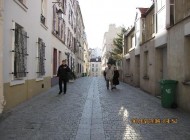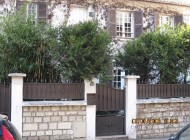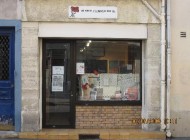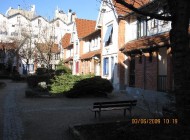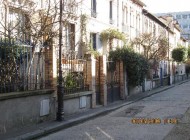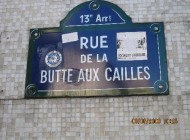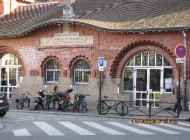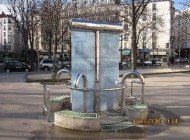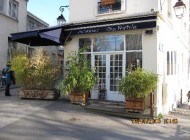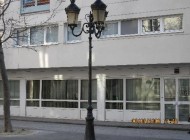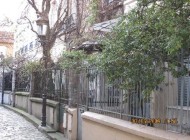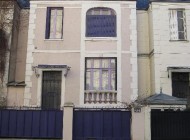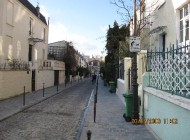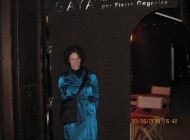We are at the apartment awaiting a French wine shipment from Engand (long, boring story for another day, if ever) so I thought I should describe our routine here, now that we’ve mostly settled in.
It’s pretty much the same as home, for a few minutes anyway. We get up, put our gym clothes on and head to the gym. Out onto rue de Vaugirard, past Boulevard Raspail, turn left at rue de Rennes and hit the gym. It’s a bit 80s, not so many business type-As, quieter music (but still techno-pop) and lots more tattoos here. Also, way more French spoken.
On the way back, we buy a paper (Sandy ran in the Jardin du Luxembourg today) from the news-agent in the kiosk at the Metro St. Placide, come back to the apartment and have our cereal and tea. I do the IHT (NYT) crossword, which I would only do on Sundays at home.
It would be nicer to head to a cafe for a pain chocolat et cafe noir, but the French metabolic rate seems infinitely better than ours (mine, anyway). Maybe they worry more?
Our apartment is comfortable and reasonably spacious. We live in a building with a number of older couples and some younger couples with families, socio-economically, middle to upper middle class I would guess. I was in our tiny elevator today with a young woman and her 3 children (4, 2 and 9 months, she told me), on her way to school or daycare. The elder boy said, “Bonjour, monsieur,” when he got in the elevator and I said the same to him. I think he corrected me but couldn’t tell for sure. Maybe he’s too young to be “Monsieur?”
The divergence starts here, no 7 a.m. call with the Prince, for example, although I have spoken with him about one matter which couldn’t be avoided over the last day or so. By this time, instead of plunging into work, we mull over the day’s activities (this being my job).
Having been to Paris at least a dozen, maybe 15, times, I know my way around pretty well, but our goal is to explore (when Sandy isn’t doing her French, me, my art lessons) the city and its environs in more depth. There are 20 arrondissements (areas), some more attractive than others, set in a circular, spiral pattern, like a snail’s shell.
There are a number of guidebooks, here, it turns out but we rely mostly on the well-known ones, Eyewitness Paris, Little Black Book of Paris, Wallpaper* (for more hip consumers) and Pudlo Paris (recently, in English translation) for cuisine. If you want more historical guides, the Michelin green guides are invaluable.We also take a detailed Michelin map. While highly accessible, especially for walking, the Paris streets aren’t rectilinear like most North American cities, New York, for example.
There are many treats to doing nothing: not worry about shaving (although that does have a certain Parisian look), dressing for court, docketing, and a number of quotidien things that we consider every day. It offers a freedom, not appreciated (at least by me) since probably 11 years old which is 50 years ago. And even that has constraints, the freedom is 3 months in length. But, today, still awaiting the wine delivery, we don’t feel the need to do something as we can always go to this gallery or that park tomorrow if we want.
However, being Type-As, we went for a long walk through the 13th (this being March 6th). The Eyewitness Paris has Eight Guided Walks. We had done all 6 from the last edition but were given the new edition by a friend and it had two additional ones. So, today we did A 90-Minute Walk in the Butte-aux-Cailles. As this blog is both monologue (I had the Blog Administrator take off the Post Comment section) and travelogue, part memoir, part memento, and since if you are reading this, you aren’t likely here, I am going to take you on a virtual walk, the one we just finished. Apart from one or two places that either weren’t there anymore or were under construction, this narrative and corresponding photographs faithfully reflects our afternoon. Ready?
Coming out of the Metro (1), along Rue Paulin-Mery (2), we were in a very quiet residential neighbourhood, becalmed by places like the house with the lilac shutters (3). On Rue Gerard (40, we saw brick terraces and plant-covered villas. Even though this is a recent Eyewitness, the theatre was under construction and the candy store turned into a Thai restaurant. Nevertheless, the Association of the Friends of the (1871) Commune of Paris (5) is still there, although we didn’t buy the T-shirt. On Passage Barrault (6), we walked along a cobbled alleyway and just off it, in Rue Daviel, there is a row of cottages, called “Little Alsace” (7) because of their chalet style but which, were, in fact, the first of Paris public housing.
Down Villa Daviel (8) onto the area’s “artery,” the Rue de la Butte-aux-Cailles (9) to the Place de la Commune de Paris (10) where there was heavy fighting in 1871. Down the street, we stopped in Les Abeilles (11), a store devoted to bee-keeping and honey-making. Naturally, we bought a few small jars. The old-fashioned creperie, Des Crepes et des Cailles (12) was closed, fortunately, as was a co-operatively-run restaurant called Les Temps de Cerises (13).
At Place Paul Verlain (14), there’s a red-brick, Art Nouveau swimming pool (15) and in the Place, a new fountain (16). Across the street is a chic-looking resto, Chez Natalie (17) and on passage Vandrezanne, a pedestrian street, there are the old-fashioned lampposts (18).
In Square des Peupliers (19), built in 1926, each house is different, “reflecting the ideals of the time.” And on Rue du Moulin-des-Prés, there are unusual stone houses (20) and an odd, purple Art Nouveau place at No. 104 (21).
Past cottages (22) on Rue Dieulafoy, back to the Tolbiac Metro and home.
Whew!
Gaya par Pierre Gagnaire, 44, rue du Bac (7th), www.pierre-gagnaire.com, was a fun, elegant place for dinner. Gaya specializes here in fish (as opposed to Gagnaire’s 3 star restaurant on rue Balzac). The service was efficient, if a tad aloof, the prices a bit steep but the marine cuisine very fine with a very reasonably priced wine list and knowledgeable sommelier to boot.
- The Place d’Italie Metro stop with Guimard design.
- Rue Paulin-Mery. Didn’t notice the green garbage bin, sorry.
- House with lilac shutters.
- Rue Gerard
- The Friends of the Commune.
- Passage Barrault.
- “Little Alsace”
- Villa Daviel
- Paris street sign.
- Place de la Commune with Wallace fountain, must have been green bin day.
- Les Abeilles
- No crepes for us.
- No cherries either.
- Place Paul Verlain. There was someone’s bust in the square with a pigeon on it, but the pigeon flew away before I could take a picture.
- Art Nouveau swimming pool.
- New fountain.
- Chez Natalie. Pudlo doesn’t mention it, but it may be new, I don’t know.
- Old lampposts.
- Houses on Square des Peupliers (1926).
- Stone house.
- I never saw a purple house, I never thought I’d see one…
- Cottages on Rue Dieulafoy.
- A l’exterieur de Gaya

